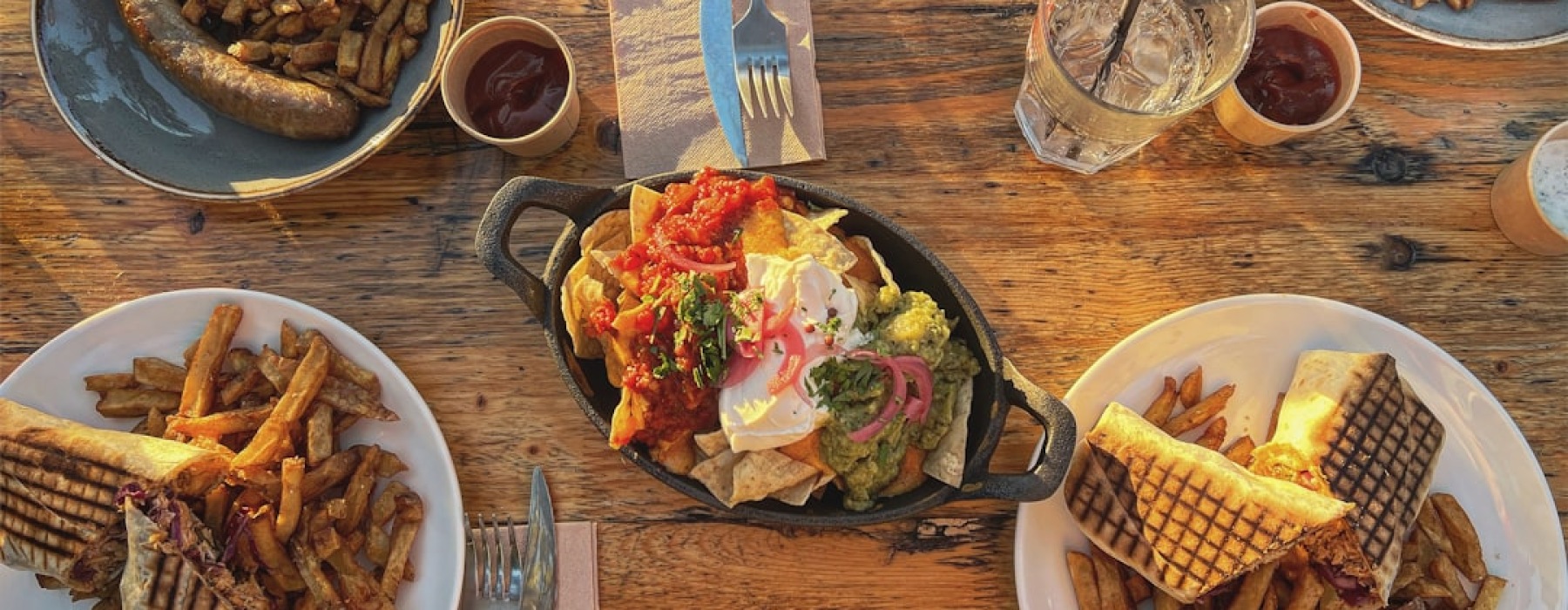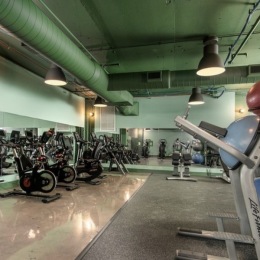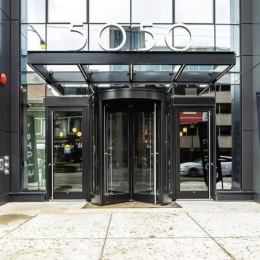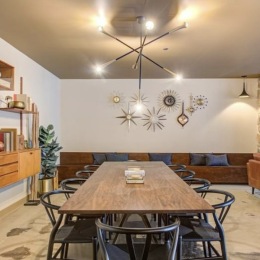Rise and Dine at These Must-Try Brunch Restaurants
Why Brunch Restaurants Have Become Weekend Destinations
Brunch restaurants have transformed from simple breakfast spots into social hubs that define weekend culture. These establishments serve more than food - they create experiences that bring communities together over leisurely meals and specialty drinks.
What makes brunch restaurants special:
- Hybrid timing: Open late morning to early afternoon (typically 10am-3pm)
- Menu variety: Combines breakfast and lunch items with creative twists
- Social atmosphere: Designed for groups and extended dining experiences
- Signature drinks: Mimosas, bloody marys, and craft cocktails
- All-day appeal: Flexible dining that fits weekend schedules
The numbers tell the story of brunch's popularity. Ruby Slipper & Ruby Sunshine serves over 40,000 biscuits per week, while establishments like Snooze Eatery have earned recognition as "Best Brunch Place" from Conde Nast.
Key elements of successful brunch restaurants include:
- Fresh, scratch-made items (like daily-baked biscuits)
- Specialty cocktail programs with bottomless options
- Welcoming atmospheres that encourage lingering
- Menu items that photograph well for social sharing
- Community connections through local sourcing
From New Orleans-style beignets to Australian-inspired specialty coffee, brunch restaurants create unique identities that reflect their neighborhoods. They've mastered the art of turning a simple meal into a weekend ritual that keeps customers coming back.
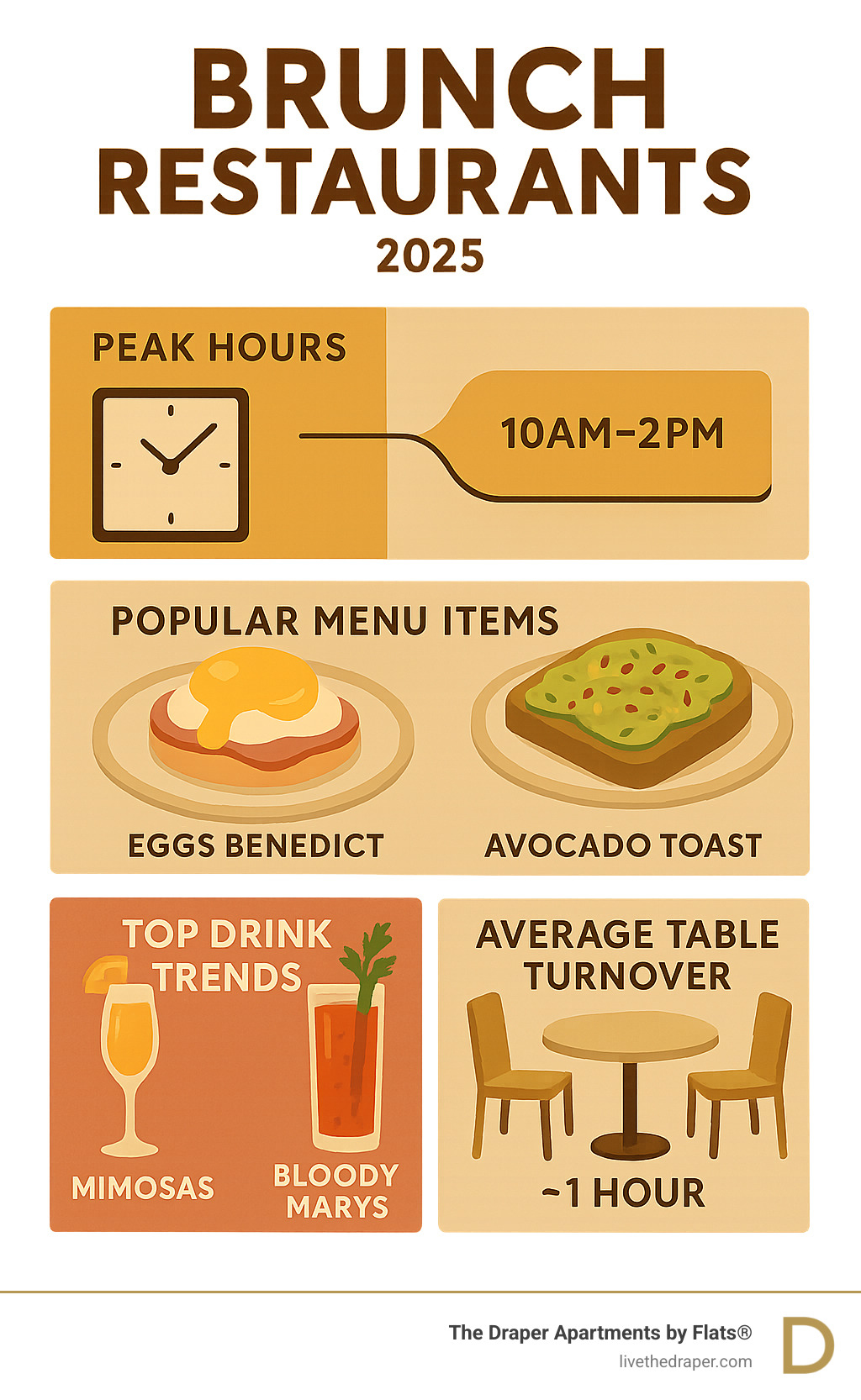
What Makes a Great Brunch Experience
The best brunch restaurants balance multiple elements to create memorable dining experiences. They understand that customers aren't just looking for a meal - they want an atmosphere where they can relax, socialize, and enjoy quality food and drinks.
Great brunch establishments focus on menu balance, offering both sweet and savory options that appeal to different tastes and dietary needs. They prioritize fresh ingredients, often sourcing locally to ensure quality and support their communities. The most successful spots create an all-day appeal that works for early risers and late sleepers alike.
Community vibe plays a crucial role in brunch success. These restaurants often become neighborhood gathering places where regulars feel welcomed and newcomers quickly feel at home.
How Brunch Differs From Breakfast or Lunch
Brunch restaurants occupy a unique space in the dining landscape. Unlike traditional breakfast spots that focus on quick service and early hours, brunch establishments accept a leisurely pace that encourages customers to linger.
The timing sets brunch apart - typically opening between 9am and 10am and serving until mid-afternoon. This schedule accommodates weekend sleep-ins while still providing substantial meals before dinner. The pace is deliberately slower, with service designed around conversation and relaxation rather than quick turnover.
Hybrid dishes define the brunch menu category. These restaurants combine breakfast staples with lunch elements, creating unique offerings like chicken and waffles, breakfast burritos with lunch-sized portions, or salads topped with poached eggs.
The social aspect distinguishes brunch from other meal occasions. While breakfast often involves solo diners or quick family meals, and lunch frequently centers on business or efficiency, brunch is inherently social. Tables are designed for groups, service accommodates extended stays, and the atmosphere encourages celebration and connection.
Must-Have Menu Items at Brunch Restaurants
Successful brunch restaurants build their reputations around signature dishes that customers crave. Research shows that certain menu items have become essential offerings that diners expect to find.
Eggs Benedict remains the gold standard of brunch dishes. This classic combines poached eggs, Canadian bacon, and hollandaise sauce on English muffins. Many restaurants create variations using different proteins, breads, or sauce preparations to make the dish their own.
Avocado toast has evolved from simple fare to an art form. The best versions feature high-quality bread, perfectly ripe avocados, and creative toppings like everything bagel seasoning, cherry tomatoes, or poached eggs.
Chicken and waffles represents the sweet-savory combination that defines brunch creativity. This dish satisfies multiple cravings simultaneously and has become a signature item at many establishments.
Beignets have gained popularity beyond their New Orleans origins. Lucile's Creole Cafe serves these "homemade New Orleans style donuts" hot as a top-selling item.
Biscuits serve as the foundation for many brunch dishes. Ruby Slipper & Ruby Sunshine's success with over 40,000 biscuits served weekly demonstrates their importance. These establishments bake biscuits fresh throughout the day, ensuring quality and warmth for every customer.
Hash browns and potato dishes provide essential comfort food elements. Blue's Egg in Milwaukee has built a reputation around signature hash brown dishes, showing how traditional items can become restaurant specialties through quality preparation.
Why Specialty Cocktails Matter
Beverage programs distinguish exceptional brunch restaurants from ordinary dining spots. Specialty cocktails transform brunch from a simple meal into a celebratory experience that justifies the leisurely pace and social atmosphere.
Mimosas anchor most brunch drink menus. The combination of champagne and orange juice creates a light, refreshing option that pairs well with both sweet and savory dishes. Many restaurants offer bottomless mimosa packages, encouraging extended stays and higher check averages.
Bloody marys provide the perfect savory cocktail option. These drinks often feature elaborate garnishes, house-made mixes, and premium vodkas. The customizable nature of bloody marys allows restaurants to showcase creativity while accommodating different spice preferences.
Espresso martinis bridge the gap between coffee and cocktails, appealing to customers who want caffeine with their alcohol. These drinks work particularly well for late-morning diners who still need their coffee fix.
Many successful brunch spots create house-made syrups and mixers that set their cocktails apart. These custom ingredients allow for unique flavor profiles and demonstrate the kitchen's commitment to quality and creativity.
| Classic Brunch Drinks | Creative Variations |
|---|---|
| Mimosa | Peach Bellini, Blood Orange Mimosa |
| Bloody Mary | Michelada, Green Goddess Bloody |
| Coffee | Cold Brew Cocktails, Irish Coffee |
| Fresh Juice | Kombucha Cocktails, Shrub Drinks |
The beverage program often drives profitability for brunch restaurants. Cocktails carry higher margins than food items, and bottomless drink packages encourage longer stays and larger group sizes.
Brunch Restaurants: Operating & Service Secrets
Behind every successful brunch experience lies careful operational planning. Brunch restaurants face unique challenges that require specialized staffing models, precise prep timelines, and strategies for managing high-turnover seats during peak hours.
Staffing models for brunch service differ significantly from traditional restaurant operations. Most establishments need their full team available during the condensed weekend rush, requiring careful scheduling and cross-training. Servers must be prepared for larger parties, longer table times, and customers who may be celebrating special occasions.
Prep timelines become critical when serving items like fresh biscuits throughout service. Establishments that bake items to order must coordinate kitchen timing to ensure consistent quality without overwhelming staff during peak periods.
Bottomless promotions require careful management to remain profitable. These packages encourage longer stays and higher satisfaction, but restaurants must monitor consumption patterns and set appropriate time limits to maintain margins.
Weekend vs. Weekday Service in Brunch Restaurants
Brunch restaurants must adapt their operations to accommodate dramatically different demand patterns between weekends and weekdays. This flexibility requires strategic planning and operational adjustments.
Weekend service typically generates 70-80% of weekly brunch revenue, creating intense pressure during Saturday and Sunday rushes. Restaurants must staff appropriately for these peak periods while managing the associated labor considerations.
Crowd sizes during weekends often exceed restaurant capacity, leading to wait times that can stretch beyond an hour. Successful establishments manage these crowds through reservation systems, accurate wait time estimates, and engaging waiting areas.
Weekday service presents different opportunities. While overall volume decreases, brunch restaurants can attract different customer segments including remote workers, retirees, and people celebrating special occasions. Some establishments offer special deals during slower periods to build consistent revenue streams.
Grab-and-go kits have emerged as an innovative solution for extending brunch appeal beyond traditional service hours. Lucile's Creole Cafe offers Pain Perdu Kits, Biscuits and Gravy Kits, and Cajun Lunch Kits that serve 4-6 people, allowing customers to recreate the restaurant experience at home.
Reservations vs. Walk-Ins—Finding the Sweet Spot
The reservation versus walk-in balance significantly impacts both customer satisfaction and operational efficiency at brunch restaurants. Different establishments have found success with varying approaches, but the key lies in matching the system to the restaurant's concept and customer base.
Online booking systems have revolutionized brunch service by allowing restaurants to manage demand more effectively. These platforms provide valuable data about party sizes, peak times, and customer preferences while reducing phone calls and administrative work.
Wait-list apps have become essential tools for managing walk-in customers. These systems allow guests to join virtual queues, receive accurate wait time estimates, and explore the neighborhood while waiting.
Some establishments operate as walk-in only venues, accepting no reservations. This approach creates a more democratic system where all customers wait equally, but it requires exceptional crowd management and clear communication about expected wait times.
Community Building Strategies
Successful brunch restaurants understand that building lasting customer relationships extends beyond individual menu items to encompass community connection. The most effective approaches balance profitability with accessibility while building lasting customer relationships.
Value bundles create perceived savings while encouraging larger orders. These packages might combine entrees with drinks, offer family-style portions, or include multiple courses at attractive combinations.
Local partnerships strengthen community connections while creating marketing opportunities. Restaurants might source ingredients from neighborhood farms, collaborate with local breweries for specialty drinks, or participate in community events.
Loyalty perks encourage repeat visits and word-of-mouth marketing. These programs might offer birthday discounts, frequent diner rewards, or exclusive access to new menu items.
For those exploring Chicago's dining scene, understanding how brunch restaurants connect with local culture improves the overall experience. More info about Chicago Best Happy Hours can help diners find how different establishments contribute to the city's vibrant food culture.
Atmosphere, Ambiance & Location Advantages
The physical environment of brunch restaurants plays a crucial role in creating memorable experiences. Successful establishments understand that atmosphere can be just as important as food quality in building customer loyalty and encouraging repeat visits.
Music playlists set the tone for the entire dining experience. The best brunch spots curate soundtracks that complement their concept while maintaining energy levels appropriate for conversation. Music should improve rather than dominate the atmosphere, creating a backdrop that encourages relaxation and social interaction.
Natural light transforms brunch spaces, making them feel welcoming and energizing. Restaurants with large windows, skylights, or glass doors create bright, airy environments that align with brunch's daytime timing. This lighting also improves food photography, supporting social media marketing efforts.
Outdoor patios extend seating capacity while providing unique dining experiences. Weather-permitting, patio dining allows restaurants to accommodate more guests during peak periods while offering customers a different atmosphere option.
Neighborhood character influences both restaurant design and customer expectations. Establishments that reflect their local community through décor, menu items, or service style create stronger connections with regular customers while attracting visitors who want authentic local experiences.
Sourcing Local & Seasonal Ingredients
Brunch restaurants that prioritize local and seasonal sourcing create multiple advantages for their operations. These practices improve food quality, support community relationships, and appeal to increasingly conscious consumers.
Farm partnerships provide access to the freshest ingredients while supporting local agriculture. Restaurants like Frank in Brussels work directly with local organic producers, sourcing ingredients "straight from the field" to ensure quality and freshness.
Sustainable seafood sourcing has become increasingly important for restaurants serving items like smoked salmon, crab benedict, or fish and chips. Establishments that prioritize sustainable options appeal to environmentally conscious diners while supporting responsible fishing practices.
Rotating specials allow restaurants to showcase seasonal ingredients while keeping menus fresh and interesting. These limited-time offerings create urgency for customers while allowing kitchens to experiment with new flavors.
Dietary Restrictions & Inclusive Menus at Brunch Restaurants
Modern brunch restaurants must accommodate diverse dietary needs to remain competitive and inclusive. The most successful establishments go beyond basic accommodations to create genuinely appealing options for all diners.
Gluten-free hashes represent one area where restaurants can excel in accommodation. Blue's Egg in Milwaukee has built a reputation for accommodating gluten-free needs while maintaining the quality and flavor that all customers expect.
Vegan scrambles and plant-based options have evolved significantly beyond basic substitutions. Creative restaurants develop egg alternatives using ingredients like tofu, chickpea flour, or specialized plant-based products that provide similar textures and flavors to traditional dishes.
Nut-free labeling becomes essential in restaurants serving items like granola, baked goods, or dishes with complex sauces. Clear labeling and staff training help prevent dangerous allergic reactions while allowing customers with restrictions to dine confidently.
Social Media & Visual Storytelling
Brunch restaurants benefit significantly from social media marketing, as their food and atmosphere naturally lend themselves to visual storytelling. The most successful establishments understand how to leverage these platforms to build brand awareness and attract new customers.
Plated aesthetics have become increasingly important as customers share their dining experiences online. Restaurants invest in presentation techniques that make their food photograph well, using colorful ingredients, artistic plating, and appealing garnishes that encourage social sharing.
User-generated content provides authentic marketing that resonates more strongly than traditional advertising. Restaurants encourage customers to share their experiences by creating Instagram-worthy spaces, signature dishes, and hashtag campaigns that build community around their brand.
The visual nature of brunch food - from colorful smoothie bowls to elaborate bloody mary garnishes - makes these establishments natural fits for platform-based marketing. Latest research on Instagram food trends shows how visual appeal directly impacts restaurant success in the digital age.
Beyond the Table: Extra Revenue Streams
Smart brunch restaurants recognize that their success depends on more than just in-restaurant dining. The most profitable establishments develop additional revenue streams that leverage their brand, expertise, and customer relationships.
Private events represent a significant opportunity for brunch establishments. These restaurants often have the space, staff, and menu flexibility needed to host celebrations, corporate meetings, and special occasions. The social nature of brunch makes these venues natural choices for events that require a welcoming, relaxed atmosphere.
Catering trays extend restaurant reach beyond their physical locations. Establishments can offer their signature dishes for office meetings, home parties, and community events. This service requires minimal additional overhead while introducing the brand to potential new customers.
Branded merchandise creates additional revenue while serving as marketing tools. Items like branded mugs, t-shirts, or packaged foods allow customers to take part of the restaurant experience home while generating profit margins often higher than food service.
Take-home kits have emerged as particularly successful revenue streams. Lucile's Creole Cafe offers multiple kit options including Pain Perdu Kits and Mimosa Kits that allow customers to recreate restaurant experiences at home. These products serve customers who want convenience while generating revenue during off-peak hours.

Catering & Private Events for Brunch Restaurants
The catering and private event sector offers brunch restaurants opportunities to significantly expand their revenue while showcasing their capabilities to new audiences. These services often provide higher profit margins than regular restaurant service while building stronger customer relationships.
Office brunch events have become increasingly popular as companies seek alternatives to traditional lunch meetings or happy hour gatherings. These events often occur during slower weekday periods, helping restaurants balance their revenue streams while accommodating corporate schedules and budgets.
Baby showers and similar celebrations align perfectly with brunch restaurant concepts. The timing, menu options, and social atmosphere make these venues ideal for life celebrations that require welcoming, comfortable environments. These events often introduce restaurants to new customer groups who may become regular diners.
Rooftop parties and outdoor events allow restaurants to maximize their space utilization while offering unique experiences. Establishments with outdoor areas can host larger groups while providing distinctive settings that justify premium pricing.
Successful catering programs require operational adjustments including specialized packaging, transportation logistics, and staff training. However, the investment often pays dividends through increased brand exposure, higher average transaction values, and more predictable revenue streams.
Standing Out in Competitive Markets
Brunch restaurants face intense competition, particularly in food-focused cities where multiple establishments compete for the same weekend customers. The most successful venues differentiate themselves through unique approaches that create memorable experiences.
Signature dish focus allows restaurants to build reputations around specific menu items. Urban Egg's recognition for "Best Pancakes in Colorado" by Taste of Home Magazine demonstrates how excellence in one area can drive overall success. Customers often choose restaurants based on their signature items, making this strategy particularly effective.
Live music transforms brunch from a dining experience into entertainment. Establishments like Ophelia's Electric Soapbox in Denver combine bottomless mimosas with live performances, creating destinations that appeal to customers seeking more than just food and drinks.
Themed pop-ups and special events create urgency and excitement around restaurant visits. These limited-time offerings encourage customers to visit more frequently while providing opportunities to test new menu items or concepts.
Location advantages play crucial roles in restaurant success. Understanding local preferences, competition, and demographic trends helps restaurants position themselves effectively. For those exploring Chicago's diverse dining scene, Best Coffee Shops in Uptown demonstrates how neighborhood character influences restaurant success.
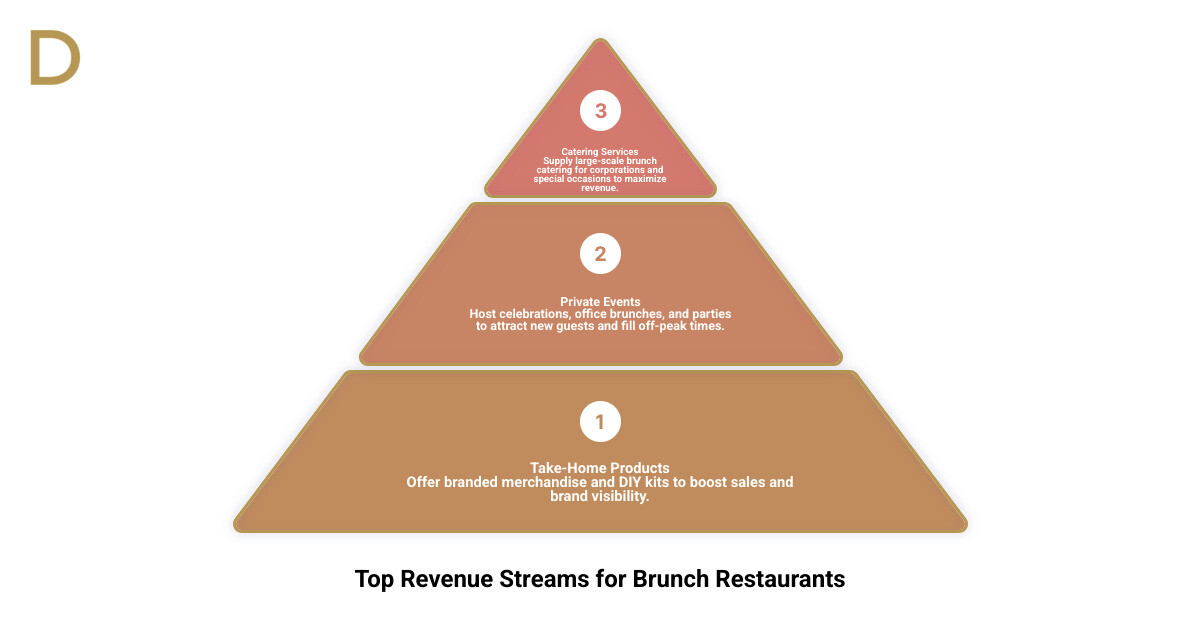
Frequently Asked Questions about Brunch Restaurants
What time do most brunch restaurants open and close?
Most brunch restaurants operate on schedules designed to capture the late-morning to mid-afternoon dining window. Typical hours run from 9:00 AM or 10:00 AM until 2:00 PM or 3:00 PM, though some establishments extend service later into the afternoon.
Weekend hours often differ from weekday schedules, with many restaurants opening later on Saturdays and Sundays to accommodate customers who sleep in. Some establishments, like Frank in Brussels, adjust their weekend hours to 10:00 AM - 4:00 PM compared to 8:00 AM - 4:00 PM on weekdays.
The closing time depends on the restaurant's concept and location. Establishments that focus primarily on brunch typically close by mid-afternoon, while those offering all-day dining may continue service through dinner hours. The key is matching hours to customer demand patterns and operational efficiency.
How far in advance should I reserve at popular brunch restaurants?
Reservation timing varies significantly based on restaurant popularity, location, and time of year. For highly sought-after brunch restaurants, weekend reservations should be made at least one week in advance, with popular spots in major cities often booking two weeks ahead.
Special occasions like Mother's Day, Easter, or Valentine's Day require even more advance planning. These peak brunch holidays can book up a month or more in advance at popular establishments.
Some restaurants operate on walk-in only policies, accepting no reservations. These establishments typically manage crowds through wait-list systems and provide estimated wait times to help customers plan their visits.
For the best experience, call restaurants directly to understand their reservation policies, as many establishments have specific rules about party sizes, time limits, or deposit requirements for weekend bookings.
Are bottomless drink packages worth it?
Bottomless drink packages can provide excellent value for customers who plan to stay for extended periods and consume multiple drinks. These packages typically include mimosas, bloody marys, or other specialty cocktails for a fixed price during a specified time period.
The value depends on individual consumption patterns and the restaurant's regular drink prices. Customers who typically order two or more cocktails during brunch often find these packages economical, while light drinkers may prefer ordering individual drinks.
Time limits and restrictions vary by establishment. Some restaurants limit bottomless packages to 90 minutes or two hours, while others may restrict the types of drinks included or require food orders to qualify for the package.
Consider the social aspect when evaluating these packages. Bottomless options encourage longer stays and more relaxed dining experiences, which can improve the overall brunch experience even if the pure economic value is marginal.
Conclusion
Brunch restaurants have evolved into essential components of modern dining culture, creating spaces where food, drinks, and social connection combine to define weekend experiences. From establishments serving 40,000 biscuits weekly to neighborhood spots crafting artisanal cocktails, these venues demonstrate that successful brunch goes far beyond simple meal service.
The most successful brunch restaurants understand that they're selling experiences rather than just food. They create atmospheres that encourage lingering, develop signature dishes that become destination draws, and build community connections that transform first-time visitors into loyal regulars.
For residents of vibrant neighborhoods like Uptown Chicago, access to quality brunch options improves the overall living experience. The combination of diverse dining choices, walkable locations, and community-focused establishments creates lifestyle advantages that extend far beyond weekend meals.
The Draper Apartments by Flats® connects residents to Chicago's exceptional dining scene, including the city's outstanding brunch culture. Our location in Uptown provides easy access to both neighborhood favorites and citywide destinations, making every weekend an opportunity to explore new flavors and experiences.
Whether you're seeking the perfect eggs benedict, innovative cocktails, or simply a welcoming space to gather with friends, Chicago's brunch restaurants offer options that satisfy every preference and occasion. For those looking to explore the best of what the city offers, Best Brunch in Uptown Chicago provides a curated guide to the neighborhood's top destinations.
The future of brunch dining continues to evolve, with restaurants adapting to changing customer preferences, dietary needs, and social trends. The establishments that thrive will be those that maintain the core elements that make brunch special - quality food, welcoming atmosphere, and genuine community connection - while innovating to meet tomorrow's dining expectations.

